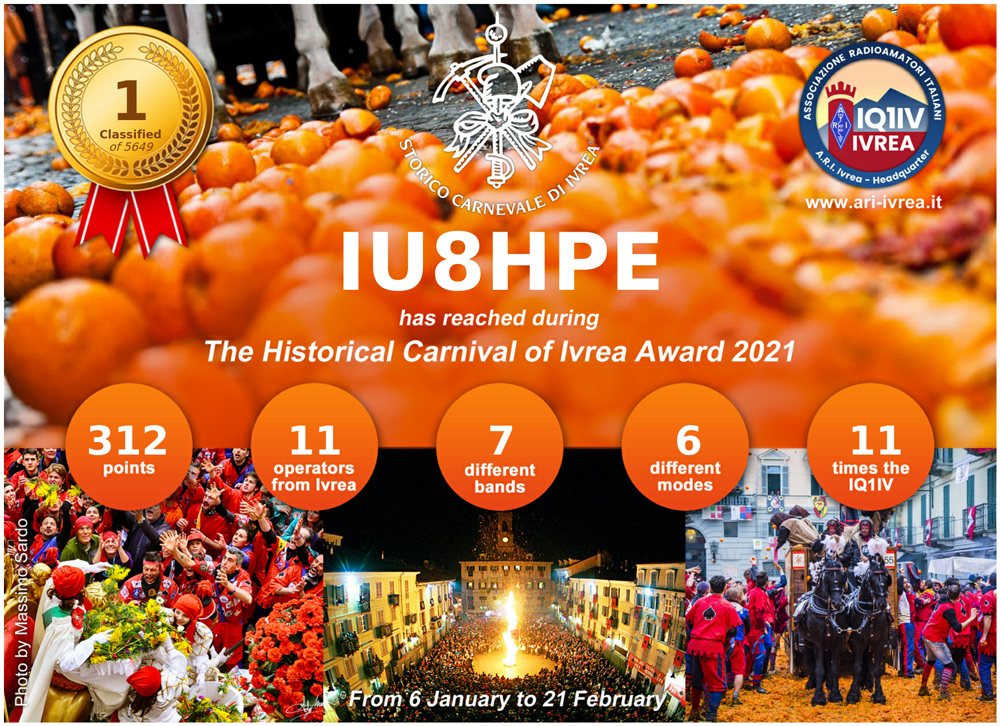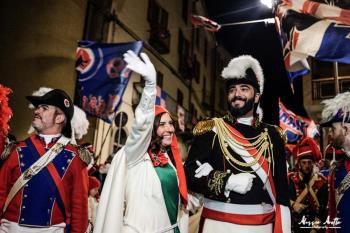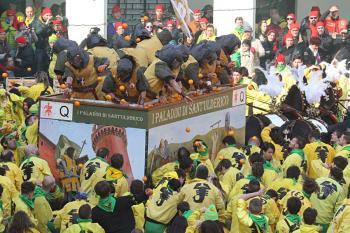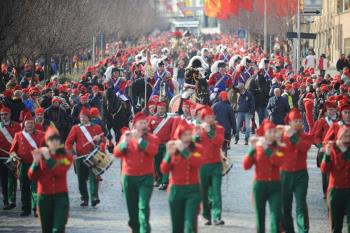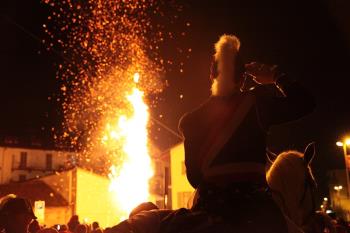JN35WL
ITU Zone: 28
CQ Zone: 15
ITU Zone: 28
CQ Zone: 15
61°
1964 - 2025
ITU Zone: 28
CQ Zone: 15
IVREA,
industrial city of
the 20th century
industrial city of
the 20th century
United Nations
Educational, Scientific and
Cultural Organization
Educational, Scientific and
Cultural Organization
HISTORICAL CARNIVAL OF IVREA 2021 - AWARD
From 6 January to 21 February 2021
Total QSO in 1746 days
Operators in the log
Countries in the log
Days left at the end
Historical Carnival of Ivrea Award
LOG SEARCH
RANKING
|
Mode
|
SSB 2593 CW 1602 FT8 1372 PSK 128 FT4 19 RTTY 17 |
|
Band
|
40 mt 2523 80 mt 1262 30 mt 652 20 mt 628 160 mt 221 17 mt 182 60 mt 167 15 mt 60 2 mt 16 10 mt 12 12 mt 7 6 mt 1 |
Official Award of the oldest Historical Carnival in Italy
The Historical Carnival of Ivrea 2021 will not to take place due to the impediments related to the CoronaVirus pandemic. The A.R.I. Ivrea members have however decided to give life to the usual radio competition to continue to celebrate the name of The Historical Carnival of Ivrea.
1. Management
The Award celebrates the Historical Carnival of Ivrea, a unique event in the world. The award is managed and issued by the A.R.I. Ivrea H.Q..
2. Start / End
From 00.00 UTC of January 6, 2021 to 23.59 UTC of February 21, 2021.
3. HAM - QSO
The award is issued after contacting the amateur radio operators Members of A.R.I. Ivrea H.Q., that expressly transmit as "station valid for the Historical Carnival diploma of Ivrea", in the period indicated in the point 2 of this rules. The list of Members that can be contacted for the issue of the award is available on the website HERE.
The QSOs (2-way) are valid with only the exchange of the R/S report (R/S/T for CW and digital modes).
4. Bands
HF (1.8 - 30 Mhz), VHF (50/144/432/1200 Mhz).
5. Modes
CW, SSB and digital modes. Satellite contacts are also allowed for VHF bands. Contacts through the use of repeaters is not allowed.
6. Ranking and Score
The award provides a final ranking for the operators who connect the amateur radio Members of A.R.I. Ivrea H.Q., based on the total sum of the points:
FT4/FT8: 3 points. For each contact with a Member of A.R.I. Ivrea H.Q., for each band and for FT4 or FT8 mode.
ex. IW1FRU ( or any other operator from THIS LIST ), contact in 40mt RTTY, 20mt PSK, 10mt PSK:
3 + 3 + 3 = 9 points
RTTY/PSK: 4 points. For each contact with a Member of A.R.I. Ivrea H.Q., for each band and for RTTY or PSK mode.
ex. IW1FRU ( or any other operator from THIS LIST ), contact in 40mt FT4, 20mt FT8, 10mt Ft4:
4 + 4 + 4 = 12 points
SSB: 5 points. For each contact with a Member of A.R.I. Ivrea H.Q., for each band and for SSB mode.
ex. IW1FRU ( or any other operator from THIS LIST ), contact in 40mt LSB, 20mt USB, 10mt USB:
5 + 5 + 5 = 15 points
CW: 10 points. For each contact with a Member of A.R.I. Ivrea H.Q., for each band and for CW mode.
ex. IW1FRU ( or any other operator from THIS LIST ), contact in 40mt CW, 20mt CW, 10mt CW:
10 + 10 + 10 = 30 points
IQ1IV: 15 points. For each contact with the A.R.I. Ivrea H.Q. (IQ1IV or IQ1IV/1), for each band and for each transmission mode.
ex. IQ1IV ( or IQ1IV/1 ), contact in 40mt LSB, 40mt CW, 20mt CW, 20mt RTTY, 10mt USB:
15 + 15 + 15 + 15 + 15 = 75 points
Each Member of A.R.I. Ivrea can only be connected once for each band and once for each mode. Any "dupe" contact will not be considered a penalty or a score. The final ranking is calculated for the highest score, the highest number of qso, the highest number of operators, the highest number of IQ1IV, the highest number of bands, the highest number of modes. The final ranking will be available on the website www.ari-ivrea.it at the end of the event.
7. How to obtain the Award
To obtain the award you need to reach a minimum of 50 points, in the period and in the manner indicated in these rules.
The award is free and does not require the sending of QSLs or any confirmation of the contacts.
If you get less than 50 points, you will still be able to receive a certificate of participation.
The award or the certificate of participation is available by downloading the file in digital format, in high resolution A4 format, without registration and through the website www.ari-ivrea.it, at the end of the event.
The Historical Carnival of Ivrea - History
The Historical Carnival of Ivrea is the oldest historical carnival in Italy whose primary rites of medieval origin – the Zappata and the embracing of the Scarlas conducted by the Abbas until the end of the 18th century – were handed down orally until 1808, the year in which it appears the first transcription of a ceremony in The Books of Verbal Processes.
The Historical Carnival of Ivrea is a unique event in which history and legend intertwine to give life to a great popular civic festival with a strong symbolic value, during which the community of Ivrea celebrates its capacity for self-determination recalling an episode of liberation from the tyranny of medieval memory.
Best known for the spectacular Battle of the Oranges, which unfolds over three days in the city’s main squares, the Carnival of Ivrea features a complicated ceremony that incorporates various eras and culminates in a historical parade. The real star of the show is the Beautiful Miller’s Daughter, a symbol of freedom and the heroine of the festival since her first appearance in 1858. Alongside her are the General, from the time of Napoleon, who leads the brilliant General Staff; the Assistant Grand Chancellor, the master of ceremonies and strict guardian of tradition; the young Priors, one for each of the five districts, and the Podestà, who represents the power of the city. To accompany the parade, a band plays the much-loved pipes and drums.
The spirit of the Carnival of Ivrea, perfectly summed up by the Carnival Song, Una volta anticamente (Once upon a time), lies in commemorating a popular uprising against the Marquess of Monferrato, who was starving the city. According to the legend, it was the heroism of Violetta, a miller’s daughter, which freed the people from tyranny. Rebelling against the droit du seigneur that the Marquess insisted upon, Violetta killed him with his own sword, and the famous Battle of the Oranges recalls this uprising.
As a sign of their participation in the festival, all citizens and visitors take to the streets wearing the classic Phrygian cap from Fat Thursday onwards on the orders of the General. This red hat, shaped like a stocking, is a symbol of solidarity with the uprising and therefore the pursuit of liberty, just as it was during the French Revolution.
For more information visit the official website of the Historic Carnival of Ivrea
www.storicocarnevaleivrea.it
The registered trademark, informations and historical notes are protected and managed by the Historical Carnival of Ivrea Foundation
The Historical Carnival of Ivrea is the oldest historical carnival in Italy whose primary rites of medieval origin – the Zappata and the embracing of the Scarlas conducted by the Abbas until the end of the 18th century – were handed down orally until 1808, the year in which it appears the first transcription of a ceremony in The Books of Verbal Processes.
The Historical Carnival of Ivrea is a unique event in which history and legend intertwine to give life to a great popular civic festival with a strong symbolic value, during which the community of Ivrea celebrates its capacity for self-determination recalling an episode of liberation from the tyranny of medieval memory.
Best known for the spectacular Battle of the Oranges, which unfolds over three days in the city’s main squares, the Carnival of Ivrea features a complicated ceremony that incorporates various eras and culminates in a historical parade. The real star of the show is the Beautiful Miller’s Daughter, a symbol of freedom and the heroine of the festival since her first appearance in 1858. Alongside her are the General, from the time of Napoleon, who leads the brilliant General Staff; the Assistant Grand Chancellor, the master of ceremonies and strict guardian of tradition; the young Priors, one for each of the five districts, and the Podestà, who represents the power of the city. To accompany the parade, a band plays the much-loved pipes and drums.
The spirit of the Carnival of Ivrea, perfectly summed up by the Carnival Song, Una volta anticamente (Once upon a time), lies in commemorating a popular uprising against the Marquess of Monferrato, who was starving the city. According to the legend, it was the heroism of Violetta, a miller’s daughter, which freed the people from tyranny. Rebelling against the droit du seigneur that the Marquess insisted upon, Violetta killed him with his own sword, and the famous Battle of the Oranges recalls this uprising.
As a sign of their participation in the festival, all citizens and visitors take to the streets wearing the classic Phrygian cap from Fat Thursday onwards on the orders of the General. This red hat, shaped like a stocking, is a symbol of solidarity with the uprising and therefore the pursuit of liberty, just as it was during the French Revolution.
For more information visit the official website of the Historic Carnival of Ivrea
www.storicocarnevaleivrea.it
The registered trademark, informations and historical notes are protected and managed by the Historical Carnival of Ivrea Foundation



